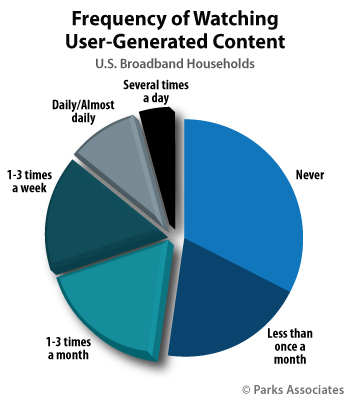47% of U.S. broadband households watch UGC more than once a month
Thursday, October 11th, 2018
47% of U.S. broadband households watch user-generated content more than once per month
- New Parks Associates industry report addresses state of live broadcast video and the shift to online broadcasts
DALLAS — A new industry report from Parks Associates finds that as U.S. broadband households spend less time per week watching video on a television, they are watching more user-generated content online, which increasingly includes live broadcast video. The Future of Live Entertainment reports 47% of U.S. broadband households watch user-generated content more than once per month.

“Total average video consumption on a television has dropped 13%, from more than 20 hours per week in 2012 to less than 17 hours per week in 2017,” said Billy Nayden, Research Analyst, Parks Associates. “In contrast, user-generated live content is gaining popularity, with platforms such as Instagram Live providing new ways for content creators to engage with their viewers in real time. As more alternatives to traditional TV emerge, all players will explore new and unique ways to package and present digital streaming as part of their services.”
By the end of 2017, 12% of U.S. broadband households were regularly watching either a live TV show or live events via a livestreaming site or app such as Twitter, Facebook, or Twitch. ABC launched a 24/7 livestreaming network in April 2018 to capitalize on this trend.
“For content whose value is its live broadcast, such as sports and breaking news, there are online alternatives emerging,” Nayden said. “Much of news consumption has moved to social media, while sports TV has shifted to digital in recent years, with many OTT options going direct to consumers, including MLB.TV, NBA League Pass, and ESPN+.”
The Future of Live Entertainment explores the state of live broadcast video, including the renaissance in live video services online, alternatives to traditional linear television, consumer use, and new opportunities for content creators and distributors. It addresses how viewership habits in live entertainment changed with the decline of pay TV and the rise of streaming. The report includes five-year forecasts of live TV viewership, including growth of live viewership and growth of online live viewership.
Additional research:
- Live-TV viewers ages 18-34 watch 30% of their live content on a TV from online video services.
- 78% of viewers between the ages of 18-49 report getting news from social media.
- 35% of digital antenna owners connect their antenna to a streaming media player.
- Just 37% of U.S. adults reported getting their news from local news, compared to 46% in 2016.
- 23% of broadband households reported posting user-generated content online in the past 30 days.
Latest News
- Netflix posts first quarter 2024 results and outlook
- Graham Media Group selects Bitmovin Playback
- Dialog, Axiata Group, Bharti Airtel agree on merger in Sri Lanka
- Yahoo brings identity solutions to CTV
- Plex has largest FAST line-up with 1,112 channels
- TV3 migrates from on-prem servers to AWS Cloud with Redge